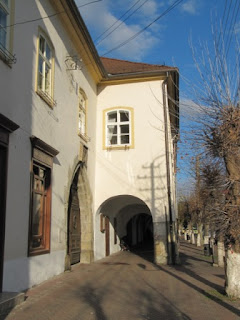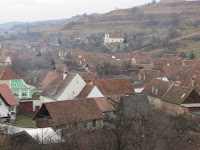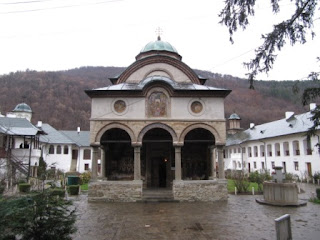20th to 25th November 2010
In comparison to Maramureş, Transylvania instantly felt like a return to the 21st century – OK, maybe the 20th then – and a coffee break in the town of Bistriţa had us sitting on white leather sofas surrounded by the young and beautiful. We felt a bit peasanty to be honest, aware that both of us needed haircuts and our trousers were a bit mud splattered, but that’s what you get from nearly 200 days on the road in a van.
Bistriţa – Şugălete row of terraced merchant’s houses and street art installation reminiscent of Antony Gormley
We didn’t really have an auspicious start to this next area. A long and fruitless evening’s search for a pension happy to accommodate us and our need for electricity left us feeling a bit down. Our solution was to park up in Reghin’s very attractive main square, draw our blinds and spend the night there. Actually, for us the centre of a town often feels a surprisingly safe place to stay, and in this case we were 200m from the police station. Besides, Reghin felt quite sophisticated, with a long, neat and tidy main street lined with burgher’s houses from its Hapsburg past. There was a bit of night life going on around us, but none of it interfered with a restful night and we woke on Sunday morning to the sound of church bells.
Reghin doorways
Can you spot a motorhome here?
We set off through gentle hills with strip fields and a new style of haystack, more like the ones I (Lesley) remember from my childhood, with rectangular bales piled high in a vague house shape (I’m not sure where I’d have seen these though, growing up as I did in London). Village houses were no longer wooden and there was far less new building going on. There were also fewer cars with foreign plates. Conversely, there were more elderly Dacias from the communist era on the roads. It made us wonder whether people round here were just not working abroad so much.
Târgu Mureş – Palace of Culture
By lunchtime we had reached the city of Târgu Mureş, where the centre had been closed to traffic and was gradually filling with strollers as the church services ended, to add to the array of people already out on a sunny Sunday, roller-blading, cycling and even uni-cycling. It reminded us of Sundays in Madrid and we stopped there far longer than we’d planned, staying for lunch and joining the strollers. The architecture impressed us greatly, especially the Palace of Culture and the town hall, which were very Art Nouveau, and built around 1910 when Transylvania was part of Hungary – thank goodness Ceauşescu didn’t have any crazy ideas about tearing those down.
Târgu Mureş – street views
Transylvania was transferred to Romania after the First World War. Large areas have Hungarian majorities, and have done for many hundreds of years; in other parts Romanians have dominated for centuries too. Who has the best claim to rule the province is a bitterly sensitive topic in Romania and Hungary, and is normally based on the ‘we were here first’ line of argument – quite idiotic and irrelevant when everyone knows that they have all been living there for centuries.
Târgu Mureş – this is some apple stall
Târgu Mureş, or Marosvásárhely to give it its Magyar name, lies in one such ethnically Hungarian area, and it struck us that a number of monuments erected after 1920 sought overtly to stake the Romanian claim to this region. A statue of Romulus and Remus sat outside the town hall, a reminder of the Romanian belief that they are directly descended from Roman settlers in this very area – and therefore here first. A huge (and very impressive) Orthodox cathedral was also built on the main square in the 1920s, and its murals pointedly depict the scenes of the Passion with Hungarian nobles in the roles of oppressors, and Christ’s followers dressed in traditional Romanian peasant garb.
Târgu Mureş – Orthodox Cathedral
Beyond the land of the Transylvanian Hungarians we entered an area that was, until quite recently, home to the Transylvanian Saxons. These German-speakers first settled here first in the 13th century, and formed a thriving community in the towns and villages more or less until the 1980s, when deteriorating conditions in Eastern Europe’s second maddest country (never forget Albania) led many of them to seek to emigrate to West Germany. The Romanian régime let them go, as it received a payment from Bonn for each German thus released. Then, after the 1989 revolution, all the restrictions were lifted, and whole villages departed en masse at the start of the 1990s, all but ending 700 years of German history here at a stroke. Very few remain, but their monuments are everywhere.
Saxon village streets
The monuments we were particularly seeking out were the fortified Saxon churches and their accompanying villages, which are typically composed of one long main street, often bordered by a wide swath of grass, and lined by single-storey stone houses placed end on to the road with their frontages joined on to the next by an archway. The impression they give is of one long, unbroken, colourful wall.
Saxon village streets
The churches certainly were striking, being generally situated on a hill and having a large defensive tower and a ring of high, thick walls. You could easily see how the villagers would be able to pile into the church, carrying all their valuables and stores in large wooden chests, when the invading Tartars and Turks attacked in the 15th and 16th centuries. We saw an exhibition of just such chests in Sighişoara’s Lutheran church. They were part of a collection of over 100 chests, found in the attic of the fortified church at Brădeni, and restored by German archaeologists. Unsurprisingly, much of the restoration work to do with these churches has a German connection.
Saxon churches (Apold, Bradeni and Merghindeal)
Inside the defensive wall at Şaroş
In Şaroş, visiting inside the church proved quite easy as the keyholder lives next door. Just go up the covered wooden staircase and knock on the green door. The very plain interior still had its simple benches laid out, hymn numbers remained on the wall boards and it was hung with fading banners covered in German writing. It all gave the place a sort of Miss Haversham feel, frozen in time and almost as if it were just waiting for the congregation to reappear. Mind you, I expect quite a lot do return every summer, on coach tours of the old homeland. We had a wander around the walls of Şaroş church, and were interested to find that the sturdy tower’s steps begin about 6 foot up the wall, requiring a ladder to reach them, which was presumably pulled up in times of need. There are good examples of these fortified churches all around this area. We stopped by those at Apold and Merghindeal, but by far the best was at Biertan, known to its former inhabitants as Berthälm.
Biertan from afar
Approaching the village, Biertan looked to have not so much a fortified church as a gothic castle, rising out of its misty valley setting, surrounded by a higgledy piggeldy collection of red tiled village roofs in a very medieval looking street pattern. Arriving on a wet November day to almost deserted streets, with a few villagers watching us driving past, made me think it would make a great setting for a Dracula film – well, it’s the right area anyway! Close up it was no less impressive, with a long covered wooden staircase taking you up through two sets of walls to the central area at the top, where the large church stands, surrounded by several defensive towers and outbuildings.
Biertan up close – castle, village and inscription in German on a village house
These covered wooden staircases seem to be a feature of this Saxon area and there was a pretty long one in the citadel at Sighişoara, which takes you up to the Lutheran church on the hill. Rob had been to Sighişoara before, twice actually, the first time before it really began to get restored. A lot of work has been done to the citadel, and, while it is definitely the tourist heart of the town, I (Lesley) felt that it hadn’t been turned into a themed gothic centre. Rob says that in the summer, with cafes and gift shops spilling out on to the streets it gives a very different impression, but on a damp November day it looked quietly understated, with its cobbled streets overhung by the steep, tiled eaves of Germanic-style houses from the 16th century.
Sighişoara – views of the clock tower in the old citadel
The lower town in Sighişoara has a completely different feel. It is a lively place, with many buildings almost as old as in the citadel, but here there were ordinary shops and lots of people out and about. We managed to have the most enormous lunch of stuffed cabbage leaves and mămăligă (polenta) at £2 per portion, and we found a replacement tube for one of the van’s interior lights, which cost 70p. We had found the campsite we were staying on quite by chance as we were driving out to find one we’d heard of on the hillside, but had no idea if it was open in November. Camping Aquarius is near the station, is a ten minute walk from the citadel, has a pension, a swimming pool and, of particular interest to us, is open all year with electricity and lovely hot showers – all for 40 Lei (£8).
Sighişoara – ripe for renovation, look at what’s under the plaster, and street scene in the lower town.
We noticed a new group of Roma in these parts of Transylvania, who wear a distinctive dress of very broad-rimmed black hats for men, and long brightly coloured skirts for women, often with knitted tops and headscarves in similar patterns which give them an uncanny resemblance to women in Indian villages.
The weather turned rainy again from Tuesday 23rd, and the next morning, while at the charming little Dutch-run campsite at Cârţa, in the far south of the Saxon area, we got the first flurries of snow. The high mountains of the Făgăraş range were invisible under a blanket of cloud, and more snow was forecast. At this point we decided to miss out on our visit to Sibiu (I, Rob, have been there before and know it’s great, but so it will be next time we come) and push straight on south through the mountains, and one step closer to Greece.
Turnu Roşu pass
The route south from Sibiu crosses the Carpathians at the Turnu Roşu pass, and stays at low altitude by following the narrow valley of the River Olt. Inevitably this has become the main truckers’ route, and we joined a constant stream of heavy lorries thundering along the winding gorge. Despite this and the low cloud, it was an impressively scenic route, which snaked past both high cliffs and pastoral, haystack-dotted slopes over a length of nearly 80km, until we emerged onto the Danubian plain around Râmnicu Vâlcea. We were now out of Transylvania and in the province of Wallachia.
Cozia monastery
The road towards the Danube then became very flat and straight. We passed through endless strings of one-storey villages, not wealthy-looking but well maintained. Many stalls had been set up by the roadside, in some villages selling wine, in others onions and in yet others cabbages. Rarely was the produce mixed in the same locality. Our contribution to the Wallachian rural economy was in buying a 2-litre bottle of white wine, of the fetească albă grape, for 10 lei (£2), straight from the producer. As darkness fell we found a motel that agreed to let us park up for a few lei, and rather begrudgingly agreed to an electric hook-up too.
Dranovăţu motel – parked up round the back
Waking to white frost covering the van windows and the temperature down to minus 2°C told us we had made the right to choice to decide to head south and take a ferry across the Danube on Thursday 25th November. It took us a few hours driving on long straight roads beside the river Olt, passing on our way through more very rustic villages set amid strip fields and vegetable plots – they seem to be big on cabbages and peppers if the roadside sellers round here were anything to go by. We saw a couple of sights new to us - several carts pulled by donkeys, and children in school uniform of sorts, who were emerging from one village school after another for their lunchtime break. At Turnu Măgurele we easily found the port, and were initially confused as the passport check came before the ticket office when we wanted information about times and prices first, only having a limited amount of lei left in our pockets. We were in fact the only people there, and a helpful customs official acted as a liaison for us, explaining that we wanted to pay half of the 49 euro fare in lei. For a 10-minute crossing, that was some fare! We just happened to have turned up as they were putting on an extra ferry for some businessmen, though we thought at first it was just for us. They were foot passengers though, making us the only vehicle on the ferry.
Turnu Măgurele to Nikopol ferry
As we waved goodbye to Romania from the Danube, we were feeling chuffed. We’d managed to get by pretty well linguistically, or at least Rob had. It’s a Latin language, and anyone with knowledge of Italian will recognise a surprising amount. Even I (Lesley) could recognise some items on menus. Plus which, after a few trips here over the years Rob found he could have a stab at most things in the language, although, as elsewhere, they do confound him by speaking back with words he doesn’t know! We were also pleased that we’d got the ferry at a reasonable time and got our gas bottle filled up. Oh yes, we forgot to mention that. We stopped at a small GPL station (LPG) and a chap just stuck in 5 litres for us for about £3, and that means that once again the Hales are cooking on gas!
Danube mid-stream – and it’s actually looking blue! Turn left for Romania, right for Bulgaria.










































Thank you very much for these reports! Our next trip will be the Balkans in July - so we're following your trip with great interest.
ReplyDeleteFrank in Toronto
http://travel.jeffersoncampervan.com/